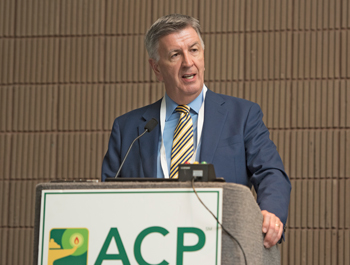
Research challenges diverticulitis dogma
The past decade has seen research on diverticulitis that may help physicians take better care of patients.
When Anne Peery, MD, MSCR, was an intern, she came across her first patient with diverticulitis.
“He was a 50-year-old man, laying on a stretcher in a hallway, doing his best not to move,” she told attendees at a session on common lower gastrointestinal diseases at Internal Medicine Meeting 2018. The patient was tender in the left lower quadrant on exam, he rated his pain as a 7 out of 10, and his CT scan confirmed acute, uncomplicated diverticulitis.
“This diagnosis made me very happy, because I knew everything there was to know about diverticulitis,” she said. “I read the whole paragraph about diverticulitis in my pocket medicine review book. I probably even read it twice. … I was feeling really confident when I went up to him to give him the plan: antibiotics and discharge home.”
But then, Dr. Peery said, her patient started asking questions, wanting to know why this happened, whether she was sure it was diverticulitis, whether it could get worse or happen again, why he needed antibiotics, and whether he would need surgery.
“These are good questions, and at the time I gave him the best answers that I could, but in the last 10 years, there's been a lot of research on diverticulitis, and much of what I told him was incorrect,” she said. “So I'm excited to tell you about this research, because as internists, many of you will see a patient like mine in a hallway, and hopefully something I tell you today will help you take better care of that patient.”
Every year in the U.S., diverticulitis is responsible for 2.5 million office visits, 333,000 ED visits, 216,000 hospital admissions, and health care costs of $3.5 billion, said Dr. Peery, who is an assistant professor of medicine at the University of North Carolina, Chapel Hill. Potential complications of diverticulitis include abscess, peritonitis, obstruction, fistula, and stricture, but most patients have uncomplicated disease and are cared for in primary care setting.
“It is for the most part an outpatient rather than an inpatient disease,” Dr. Peery said.
Incidence increases by age and differs by gender. Before age 50, the condition is more common in men, and after age 60, it is more common in women, she noted. Genetics also contributes substantially to risk, Dr. Peery said. Research has shown that patients who have a sibling with diverticulitis can have three times the risk for the disease and that 50% of the susceptibility to diverticulitis comes from inherited factors.
Research has also shown that a low-risk lifestyle decreases risk of incident diverticulitis by 50%, she said. She described a low-risk lifestyle as one that includes a diet of less than 51 g of red meat and more than 23 g of dietary fiber per day, at least two hours of vigorous physical activity per week, a normal body mass index, and no history of smoking.
Nuts, seeds, and popcorn have long been considered risk factors for diverticulitis, since it was thought that they could get trapped in the diverticula and precipitate incidence, but their bad reputation is unearned, according to Dr. Peery. “They are not risk factors,” she said.
However, regular use of NSAIDs, defined as at least twice a day, is an important but little-known risk factor, doubling the risk, she said. “Aspirin also increases the risk, but not to the degree of NSAIDs.” Chronic use of corticosteroids is another risk factor. “We think it also increases the risk of complicated disease, and this probably can be extended to other immunosuppressants,” she said.
Patients with diverticulitis typically present with acute-onset pain in the lower left quadrant that is constant and worsens with movement, Dr. Peery said. “The triad of diverticulitis is left lower quadrant pain, fever, and a white count, but you should know that among patients with diverticulitis, 40% are afebrile, and 20% of patients with diverticulitis do not have a white count,” she said.
Dr. Peery stressed that every patient who presents with lower GI symptoms should get a digital rectal exam. “You want to rule out a stricture. You want to rule out a mass. With a stricture or a mass, the rectum begins to fill, the sigmoid colon begins to fill. These patients present not with anorectal symptoms but with abdominal pain.”
Patients with diverticulitis may be tender on digital rectal exam, because the rectum sits next to the sigmoid colon, Dr. Peery said. Also, she noted that if there is gross blood in the rectal vault, the patient is very unlikely to have diverticulitis.
Presumptive diagnosis based on history and physical is right only 50% of time, Dr. Peery said. “Because it's difficult to make a diagnosis, there have been several attempts at creating decision-making tools,” she said. One tool found that exclusive left lower quadrant pain, absence of vomiting, and an elevated C-reactive protein level was very specific for diverticulitis. However, its sensitivity was low.
“It's hard to make a diagnosis of diverticulitis, which is why CT imaging is important,” she said.
Abdominal CT should be done in patients with suspected diverticulitis if there is any concern about a possible complication, Dr. Peery said. She also noted that CT is useful for confirming a first episode of diverticulitis and for documenting recurrence. However, the test isn't perfect: A recent trial found that 1% of patients found to have acute uncomplicated diverticulitis on CT actually had colon cancer.
U.S. guidelines recommend colonoscopy eight weeks after a first diverticulitis episode to avoid this misdiagnosis, Dr. Peery said. However, she said, “If your patient has had a high-quality screening exam in the last two to three years, they don't need a repeat colonoscopy.”
Regarding prognosis, 2% of patients with CT-confirmed uncomplicated diverticulitis develop an abscess greater than 5 cm or a perforation within six months, Dr. Peery said. Five-year incidence of recurrence after a first episode is 20%, and among those patients, 44% have another recurrence within five years.
Recurrent diverticulitis is not associated with an increased risk of complications, however, Dr. Peery stressed. “We used to tell our patients, ‘Gosh, that next episode might be really really bad. You might need emergency surgery,’” she said. “We were wrong. That's not true.” She also noted, however, that persistent mild to moderate abdominal pain is common in patients with diverticulitis after the acute inflammation has resolved. A recent trial found that it affects 40% of patients at one-year follow-up.
Historically, treatment for diverticulitis has consisted of a clear liquid diet and a course of antibiotics, Dr. Peery said. The liquid diet is given until symptoms begin to improve, at which point the patient can advance to a low-fiber diet, then finally to a balanced, healthy diet once symptoms resolve.
Dr. Peery noted that there has been debate about the use of antibiotics in uncomplicated diverticulitis, with some researchers questioning whether the condition may be due to focal inflammation rather than focal infection. Two recent randomized controlled trials in Europe found no difference in time to recovery from acute symptoms in patients with CT-confirmed diverticulitis who received antibiotics versus those who did not.
“Based on these trials, several European countries now recommend that acute uncomplicated diverticulitis be managed conservatively without antibiotics,” Dr. Peery said.
U.S. guidelines from the American Gastroenterological Association, meanwhile, suggest that antibiotics should be used selectively rather than routinely in patients with acute uncomplicated diverticulitis. This is a conditional recommendation based on low-quality evidence, Dr. Peery noted. The guidelines also recommend that antibiotics be given to patients with diverticulitis and complications, severe symptoms, or comorbid conditions and to those who are immunocompromised. Physicians can consider withholding the drugs in patients with CT-proven uncomplicated diverticulitis who are stable, immunocompetent, and have good social support, Dr. Peery reported.
“But there are still big questions whether or not omitting antibiotics impacts the chronic sequelae,” she said. “So I personally will continue to treat my patients with diverticulitis [with antibiotics] until we have better evidence.”
Patients with diverticulitis will turn to their primary care physicians for advice on how to avoid recurrence, Dr. Peery told her audience. “You do not want to recommend probiotics, cyclic antibiotics,” she said. “There's no evidence that these things prevent recurrence.” Mesalamine should not be recommended, either, Dr. Peery said, since seven randomized trials have shown that it does not affect recurrence risk.
Regarding modifiable risk factors, “We have no idea whether changing [them] will reduce the risk of recurrence,” she said, “but it is still reasonable to suggest to your patients that they stop smoking, avoid NSAIDs, adopt a healthy diet, and exercise.”
If patients continue to have recurrences that are significantly decreasing their quality of life, referral to a colorectal surgeon for elective hemicolectomy can be considered, Dr. Peery said. When discussing this option with her patients, she reviews the natural history of diverticulitis and explains that a recurrence similar to previous episodes is likely. She also reviews the severity and frequency of past episodes as well as their impact on quality of life in order to help patients come to a decision.
“If you have a patient who is chronically immunosuppressed, that might lower your threshold for considering an elective hemicolectomy, because they are at increased risk of complications,” she said.
Potential benefits of the surgery include a reduction in severity and frequency of episodes and a beneficial impact on quality of life. There are downsides, too, however, Dr. Peery pointed out. She said she stresses to her patients that this is major abdominal surgery that will keep them in the hospital for three to six days and that the surgery carries a significant risk for adverse events.
“After an elective hemicolectomy, you still have some colon left. Five percent of patients will have another episode of diverticulitis. I see them in my clinic and they are not happy,” she said. “Also, for patients who have chronic abdominal pain and recurrent diverticulitis, the procedure will not make their abdominal pain any better.”



